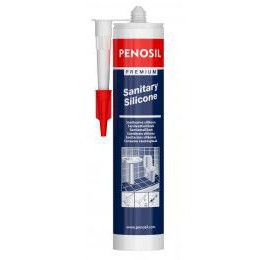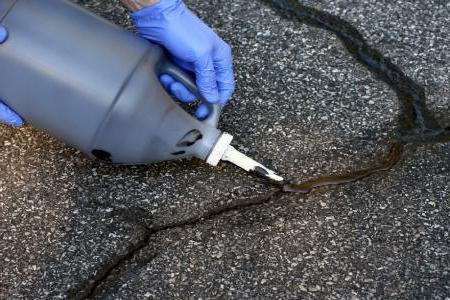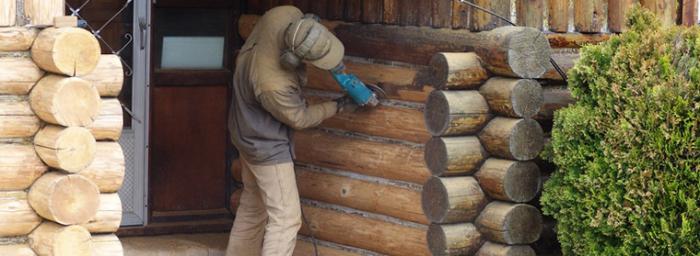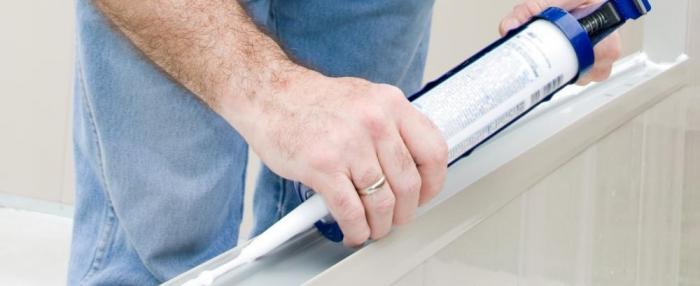Silicone sanitary sealant: how to apply and why
Those who are self-installersplumbing equipment, not having experience, know how difficult it is to cope with such elements as water. She continually drips somewhere, whistles or flows. Previously, rags and cement were used to seal, for example, cracks in sewer pipes at home. The joints of the pipes were wound with rags and plastered them with a solution. It was a dirty, sometimes ineffective method of removing leaks.
But progress does not stand still, now there is a more convenient way to perform this work even for an inexperienced person, and silicone sanitaryware will help in this.

What is
The sealant paste itself is similar in consistence todental, is usually realized in plastic tubes with a volume of 280 to 310 ml. Tuba has a long nose with a cap. Its shape is specially made for the mounting gun, in which the piston moves when the trigger is pressed and silicone sealant for plumbing works through the nozzle of the tube is easily squeezed out.
This body design allows for easyget to hard-to-reach places and gently apply a layer of sealant on the slit. At the end of the work, the nose is closed with a cap and stored for a long time.
For small amounts of work, for example, when you need to repair a small problem area, a silicone sanitaryware sealant is used in aluminum tubes.
Also, there are sealants in the file packages, but they are used less often, mostly by professionals in pairs with a special gun.
The sealant is recommended to be stored indoors at a temperature of up to 30 ° C. In this case, the package must be hermetically sealed. It is forbidden to pour sealant into another container and store it for more than 2 years.
Composition
Silicone sealant is a rather complex chemical substance. To produce it, the following components are used:
- Silicone rubber is used as a basis.
- To add strength, an amplifier is added.
- Color gives filler.
- For the viscosity and elasticity, a vulcanizer is used.
- A reliable contact with the surface provides an adhesion primer.
- To improve the elasticity, a silicone plasticizer is used.
Silicone sealants are divided into acidic (or"Vinegar" because of the characteristic odor) and neutral, depending on the constituents of the vulcanizer. Neutral sealants are amine, amide, alcohol and oxime.
The functional properties of the sealant depend on itscomposition and components. For example, acid sealants are not allowed for aluminum, cement-containing metals and marble. And for neutral sealant, there are no such limitations.

Where applicable
Sanitary silicone sealants are used inmainly in rooms with high humidity (toilet, bath and kitchen) for filling and sealing joints between the wall and sink, bath, washbasin, toilet bowl and other sanitary equipment. Also, silicone sanitaryware transparent is used on joints of low-pressure plumbing pipes, such as sewerage, draining and so on. It is also well suited for baths and washbasins not of white color for sealing joints. Sometimes they fill the space between the glass and the tree, for example, on windows or doors.
For home repair are more often usedone-component sealers. They harden due to moisture in the air. In the industrial application, two-component sealants have become widespread. Their second name is "silicone compounds." This material hardens by mixing with the catalyst.

Advantages of silicone sealant
The use of silicone sealant has several advantages:
1) After application and smoothing,even matte surface, sometimes even imperceptible to the eyes. For example, the sealant silicone sanitary white visually merges with ceramic washbasins and white bathtubs.
2) It has a long service life.
3) It has water repellent properties.
4) Withstands a short-term temperature from -50 ° C to 150 ° C.
5) Special additives in the composition, prevent the formation of fungus and mold.
6) High level of adhesion, that is, firmly grasp the material that is sealed.
Application features
Before use, it is recommended to clean the surface of dust and dirt, and then degrease it. In order to make the seam as smooth as possible, it is necessary to glue the painting tape.

After the silicone sealant is appliedplumbing, it is gently smoothed with a spatula until an even surface is formed. Categorically you can not do this with your finger, as this can lead to chemical burns and allergies. After twenty minutes of aging, the solution can no longer be corrected, because the material changes its properties, the connection may turn out to be unstable. Harmful gases are also released during work, therefore it is recommended to ensure good ventilation of the workplace.
The use of silicone sealant with acrylic baths and shower cabins is highly undesirable, since it leads to damage to the surface of the latter.
Before use, it is necessary to read the recommendations for use and follow them, and everything will necessarily happen.

Conclusion
Having considered all the advantages of this wonderfulmaterial, one can not help saying that this is really an irreplaceable thing when working in rooms where water runs. Separately I would like to note the silicone sealant plumbing "Moment", which is distinguished by its versatility and high quality for reasonable money. With a high-quality sealant, this once-unpleasant job - covering up leaks and cracks - can turn into a pleasant pastime when beautifying your home.








